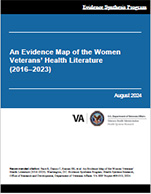
|
Recommended citation: |
Download PDF: Complete Report, Executive Summary, Report, Appendices
This evidence map identified 933 articles relevant to Women Veterans' health published since 2016, an increase from 440 articles published between 2008-2015 and 195 articles between 2004-2008. Areas of growth include reproductive health, reproductive mental health, interpersonal violence, and VA research priorities such as pain and suicide. Areas for future research include long-term care/aging, cancer, and menopause.
The number of women using the VA for health care increased 2.8-fold since 2000, with women Veterans using outpatient care at a higher frequency than their male counterparts. Women Veterans tend to be younger, more racially and ethnically diverse, and are more likely service-connected than Veteran men. Thus, it is critical that the VA keep up with the research landscape in order to provide evidence-based care to women Veterans across their lifespan.
Of the included studies, most (81%) used an observational design. While there was a 3-fold increase in the number of clinical trials since the 2008-2015 map, the total number remains very low (k = 27). The three largest areas of primary focus were "general mental health" (k = 203), "chronic medical conditions" (k = 137), and '"interpersonal violence" (k = 121). Areas of notable growth included "reproductive health" (3.7-fold increase), "reproductive mental health" (5.3-fold increase), "interpersonal violence'"(4.5-fold increase), and VA research priority areas including "chronic pain/opioids" (4.3-fold increase) and "suicide/non-suicidal self-injury (NSSI)" (4.2-fold increase). Emerging areas include "harassment and discrimination" experienced within the context of VA care, sleep disorders, disordered eating, and "toxic exposures." Gaps were noted in the areas of cancer, menopause, reproductive mental health, chronic medical conditions, mid-life care, and the impacts of intersectional identities for women from racially and ethnically minoritized populations.
An Evidence Map of the Women Veterans' Health Literature (2016-2023) (Management Brief)
Goldstein KM, Pace R, Dancu C, et al. An Evidence Map of the Women Veterans’ Health Literature, 2016 to 2023: A Systematic Review. JAMA Network Open. 2025; 8(4):e256372. DOI https://doi.org/10.1001/jamanetworkopen.2025.6372.